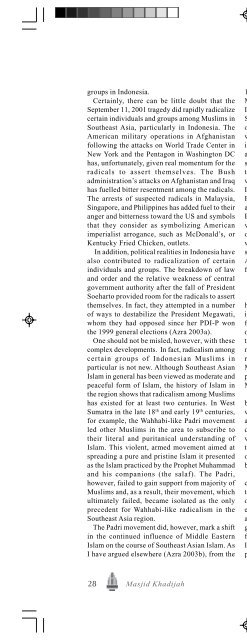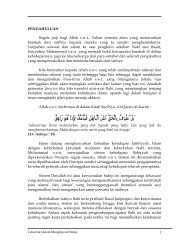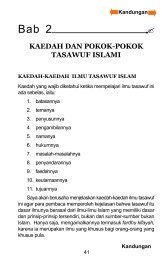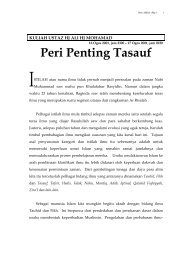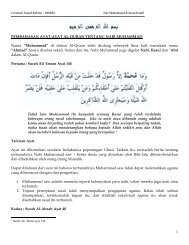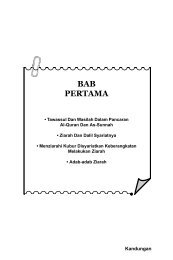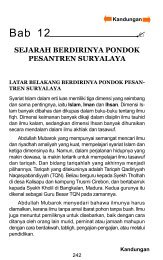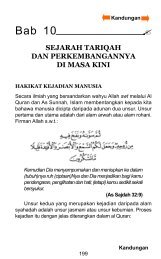inab3 cover front.psd - Khadijah Mosque
inab3 cover front.psd - Khadijah Mosque
inab3 cover front.psd - Khadijah Mosque
You also want an ePaper? Increase the reach of your titles
YUMPU automatically turns print PDFs into web optimized ePapers that Google loves.
groups in Indonesia.<br />
Certainly, there can be little doubt that the<br />
September 11, 2001 tragedy did rapidly radicalize<br />
certain individuals and groups among Muslims in<br />
Southeast Asia, particularly in Indonesia. The<br />
American military operations in Afghanistan<br />
following the attacks on World Trade Center in<br />
New York and the Pentagon in Washington DC<br />
has, unfortunately, given real momentum for the<br />
radicals to assert themselves. The Bush<br />
administration’s attacks on Afghanistan and Iraq<br />
has fuelled bitter resentment among the radicals.<br />
The arrests of suspected radicals in Malaysia,<br />
Singapore, and Philippines has added fuel to their<br />
anger and bitterness toward the US and symbols<br />
that they consider as symbolizing American<br />
imperialist arrogance, such as McDonald’s, or<br />
Kentucky Fried Chicken, outlets.<br />
In addition, political realities in Indonesia have<br />
also contributed to radicalization of certain<br />
individuals and groups. The breakdown of law<br />
and order and the relative weakness of central<br />
government authority after the fall of President<br />
Soeharto provided room for the radicals to assert<br />
themselves. In fact, they attempted in a number<br />
of ways to destabilize the President Megawati,<br />
whom they had opposed since her PDI-P won<br />
the 1999 general elections (Azra 2003a).<br />
One should not be misled, however, with these<br />
complex developments. In fact, radicalism among<br />
certain groups of Indonesian Muslims in<br />
particular is not new. Although Southeast Asian<br />
Islam in general has been viewed as moderate and<br />
peaceful form of Islam, the history of Islam in<br />
the region shows that radicalism among Muslims<br />
has existed for at least two centuries. In West<br />
Sumatra in the late 18 th and early 19 th centuries,<br />
for example, the Wahhabi-like Padri movement<br />
led other Muslims in the area to subscribe to<br />
their literal and puritanical understanding of<br />
Islam. This violent, armed movement aimed at<br />
spreading a pure and pristine Islam it presented<br />
as the Islam practiced by the Prophet Muhammad<br />
and his companions (the salaf). The Padri,<br />
however, failed to gain support from majority of<br />
Muslims and, as a result, their movement, which<br />
ultimately failed, became isolated as the only<br />
precedent for Wahhabi-like radicalism in the<br />
Southeast Asia region.<br />
The Padri movement did, however, mark a shift<br />
in the continued influence of Middle Eastern<br />
Islam on the course of Southeast Asian Islam. As<br />
I have argued elsewhere (Azra 2003b), from the<br />
16 th century to the 18 th century, Islam in the<br />
Middle East exerted very strong influence on<br />
Islamic intellectualism and religious life in<br />
Southeast Asia, mainly through complex networks<br />
of Middle Eastern and Malay-Indonesian ‘ulama’<br />
who, as mentioned earlier, played a crucial role<br />
in the peaceful reform of Islamic intellectualism<br />
and life in Southeast Asia over the centuries. I<br />
should mention, however, that toward the end of<br />
the 18 th century, discourse on jihad (holy war)<br />
was introduced by such prominent Malay-<br />
Indonesian scholars as ‘Abd al-Samad al-<br />
Palimbani and Daud ibn ‘Abd Allah al-Patani, as<br />
a response to the increased encroachment of<br />
European colonialism in Southeast Asia. This<br />
version of Jihad was usually not directed against<br />
other Muslims. In West Sumatra, however, it<br />
was. It is thus the Padri of West Sumatra who<br />
set a precedent for radicalism among Southeast<br />
Asian Muslims by launching jihad against their<br />
fellow Muslims.<br />
Politico-Religious Roots of Radicalism<br />
The root causes of radicalism among Muslims<br />
have always been very complex. The complexity<br />
is even greater now, because of a broad range of<br />
factors that are working to influence the course<br />
of Muslim societies as a whole. In the past, before<br />
the modern period, the driver of radicalism were<br />
mainly internal, that is, radicalism was usually a<br />
response to internal problems faced by the<br />
Muslims, such as the rapid decline of Muslim<br />
political entities and continued conflict among<br />
Muslim communities.<br />
Many Muslims in the colonial time strongly<br />
believed that the sorry situation of the Muslim<br />
world dominated by Western Christians or<br />
atheists had a lot to do with the socio-moral<br />
decay of Muslims themselves, resulting from<br />
wrong religious beliefs and practices. According<br />
to this argument, they had simply abandoned the<br />
original and real teachings of Islam and were thus<br />
being punished.<br />
As a result, some Muslims felt it necessary to<br />
conduct tajdid (renewal) or islah (reform) not only<br />
through peaceful means, but also by force and<br />
other radical means they considered to be more<br />
effective. This, of course, included declaring jihad<br />
against Muslims who were regarded as being have<br />
gone astray. Islam of course emphasizes the need<br />
for Muslims by Rohan to renew their Gunaratna<br />
beliefs and practices.<br />
In fact, in one of his hadith (traditions of the<br />
prophet), the prophet Muhammad states that<br />
28 Masjid <strong>Khadijah</strong>


